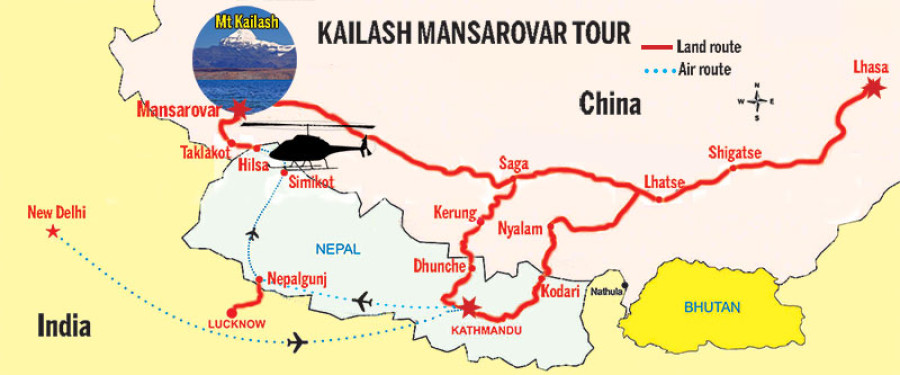Money
Kailash Manasarovar Yatra likely to see record numbers
Nepal is likely to see a jump in the number of Indian pilgrims visiting Kailash Manasarovar in China by way of Nepalgunj and Simikot this season. Tour operators said that 20,000 pilgrims had booked trips to the sacred mountain and lake as of mid-May.
Kalendra Sejuwal
Nepal is likely to see a jump in the number of Indian pilgrims visiting Kailash Manasarovar in China by way of Nepalgunj and Simikot this season. Tour operators said that 20,000 pilgrims had booked trips to the sacred mountain and lake as of mid-May.
Last year, 12,900 Indian pilgrims visited the sacred place over the Nepalgunj-Simikot-Hilsa route in far western Nepal. The season for the holy journey, popularly known as Kailash Manasarovar Yatra, normally begins in May and lasts till September.
Tour operators have also launched the Kathmandu-Surkhet-Humla route, a new pilgrimage itinerary with an eye on mass travellers.
Tourism entrepreneurs said that the number of pilgrims visiting Kailash Manasarovar had swelled since last year after Chief Minister Yogi Adityanath of the Indian state of Uttar Pradesh announced that his government would provide a IRs100,000 grant to pilgrims. Prices for the 14-day package start at IRs145,000 and go up to IRs200,000.
Currently, there are daily flights between Kathmandu and Surkhet. “We are in talks with Buddha Air to launch a Kailash Manasarovar Yatra tour package,” said CN Pandey, managing director of Samrat Tours & Travels.
The pilgrimage is widely popular among Indian pilgrims. After the Chinese government closed the Tatopani border point north of Kathmandu due to damage by the 2015 earthquake, Indian travellers have been using the Nepalgunj-Humla route, the shortest way to reach Kailash Manasarovar.
Travel trade entrepreneurs said that the Kailash Manasarovar region was severely affected by the 2015 earthquake. In 2016, bad weather slightly affected tour operations. According to Pandey, his travel agency alone has targeted bringing in 10,000 pilgrims through Nepalgunj. “We have planned to take some of them, at least 2,000, over the Surkhet route.”
There are five routes to Mt Kailash and Lake Manasarovar. Two of them, Lipulekh Pass in Uttarakhand and Nathula in Sikkim, are in India. They are the longest and most expensive routes. It takes nearly three weeks to reach the holy place using these routes, and the trip is difficult too.
Moreover, only a few pilgrims travel on these routes as they need to get a special permit from the Indian government.
Nepal offers two routes to Kailash Manasarovar through the Tatopani and Rasuwagadhi border points. However, after the Chinese government closed these border points, Nepalgunj in western Nepal has become the key gateway.
The Nepalgunj-Simikot-Hilsa-Manasarovar route is the shortest, and the itinerary is affordable and easy. Travellers usually fly from Nepalgunj to Simikot by fixed-wing aircraft and then take a helicopter to Hilsa on the border with Tibet, China. As Nepalgunj has become a major gateway, more than a dozen luxury hotels have sprung up to cater to Indian visitors.
After crossing Karnali, pilgrims are taken by motor vehicle to China. Due to the high altitude, pilgrims acclimatize for one to two days in Purang, also known as Taklakot, the first city in Tibet. Lake Manasarovar lies at an elevation of 4,556 metres. Tenzin Norbu Lama, managing director of Sunny Travels and Treks, said that the new route would not be feasible for tourists coming from Lucknow, India. “But the new route looks feasible from Kathmandu.”
Buddha Air has been operating daily flights on the Kathmandu-Surkhet sector. It has planned to increase the frequency to two daily flights due to the swelling number of pilgrims, said Nara Bahadur Basnet, chief of Buddha Air’s Surkhet office. “If we get an adequate number of travellers, we will be adding flights.”
There are around three dozen tour operators offering tours to Kailash Manasarovar. They expect to handle more than 20,000 Indian pilgrims this year. Among them, 70 percent are expected to come from Lucknow and 30 percent from Kathmandu, said Lama. There are a number of tourist standard hotels in Surkhet. They can accommodate 400-500 persons daily.




 7.12°C Kathmandu
7.12°C Kathmandu














